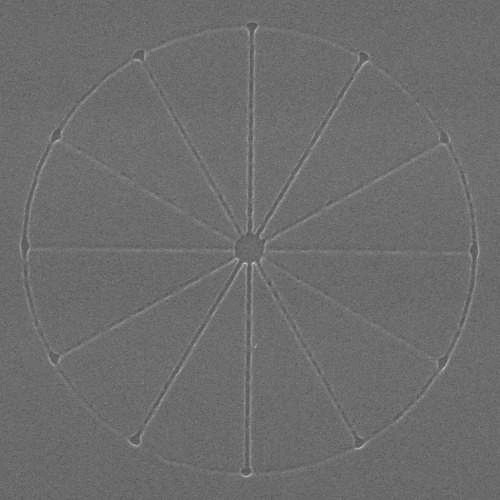 These
two images show the same 10 micron diameter wheel pattern written with the
identical dose on the same sample. All conditions were identical, except
the choice of the microscope magnification.
These
two images show the same 10 micron diameter wheel pattern written with the
identical dose on the same sample. All conditions were identical, except
the choice of the microscope magnification.
Virtually every electron microscope will have optimum values for the magnification which provide the best signal-to-noise in the pattern writing. The NPGS Manual provides detailed information on determining the microscope magnification settings that will produce the best lithography.
In this case, the top picture shows the wheel pattern that was written at a microscope magnification setting of 1700x, which corresponded to a writing field size of about 111 microns square.
The enlarged junctions at the rim of the wheel indicate that either the beam was not well focused during the pattern writing or it was moving around making it act like an unfocused beam. The identical exposure below at a slightly higher magnification shows that the beam was well focused.
In other cases, patterns written at a bad magnification value may show significant astigmatism and/or periodic noise, typically at line frequency.
 This image
shows the identical exposure as above, however, the pattern was written at
a microscope magnification setting of 1800x, which corresponded to a writing
field size of about 105 microns square.
This image
shows the identical exposure as above, however, the pattern was written at
a microscope magnification setting of 1800x, which corresponded to a writing
field size of about 105 microns square.
Even though the writing field size only changed by about 5%, a very dramatic improvement in the writing quality was obtained once the proper magnification was selected.
Wheels written with lower line doses at this magnification had linewidths down to ~30 nm, while the 1700x patterns were barely observable at the lower doses.